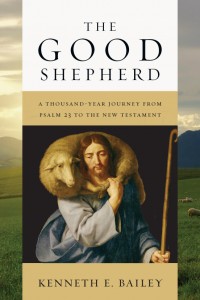The Good Shepherd by Kenneth Bailey
Psalm 23
The Lord is my shepherd; I shall not want.
He makes me lie down in green pastures.
He leads me beside still waters.
He restores my soul.
He leads me in paths of righteousness
for his name’s sake.
Even though I walk through the valley of the shadow of death,
I will fear no evil,
for you are with me;
your rod and your staff,
they comfort me.
You prepare a table before me
in the presence of my enemies;
you anoint my head with oil;
my cup overflows.
Surely goodness and mercy shall follow me
all the days of my life,
and I shall dwell in the house of the Lord
forever. (ESV)

The beauty of the 23rd Psalm has resounded throughout the ages. This is one of the most recognizable passages of Scripture. Often, when I sit down to read Scripture, I begin by flipping open to Psalm 23. It brings comfort through its beautiful imagery. Beyond the 23rd Psalm and throughout the Bible, however, we encounter this “good shepherd” imagery often.
In this academic work, Kenneth Bailey (author of Jesus Through Middle Eastern Eyes and Paul Through Mediterranean Eyes) traces the use of this imagery through Scripture from the beginnings in the 23rd Psalm to its use within the early church as seen in 1 Peter. What ensues is “a thousand-year journey from Psalm 23 to the New Testament,” as the subtitle indicates.
The Good Shepherd specifically looks at four OT passages and five NT passages, which were chosen because they all have overlapping themes with the 23rd Psalm. These are: Psalm 23, Ezekiel 34, Zechariah 10, Matthew 18, Mark 6, Luke 15, and 1 Peter 5.
From the start, Bailey gives the disclaimer that The Good Shepherd is not a full technical commentary on these passages, but rather a focused work on “the unfolding of the extraordinary story that is created in Psalm 23 and repeated (with changes) across a thousand years” (p. 27). One of the most helpful features that I found was that at the end of each chapter, after discussing the passage, Bailey gives a “theological cluster.” These serve as a sort of conclusion, basically summarizing what we can take from the imagery and themes which evolve with each passage.
What Bailey aims to show us is that there is continuity between the good shepherd tradition as presented and expressed within the nine passages of Scripture that The Good Shepherd looks at. Generally speaking, he presents the movement of the good shepherd imagery through Scripture as going from “the good shepherd is God” to “the good shepherd is Jesus” to “the good shepherd is a model for church elders.”
For someone wanting to study the good shepherd imagery in Scripture, this is a fantastic resource. Kenneth Bailey, as he has in his other works, bring with him book knowledge, as well as experiential knowledge of the biblical lands, having lived and worked among them.
“The good shepherd from Psalm 23 to 1 Peter 5 is a guide for good shepherds in every generation.” -Kenneth Bailey
Considering Bailey’s suggestion that the good shepherd tradition eventually moves toward “the good shepherd is a model for church elders,” I think this is a valuable book for those in ministry. What are “pastors” if they aren’t “shepherds?” I won’t go on about how I think ministers ought to be readers, but I do. And, although this comes from the academic imprint of InterVarsity Press, anyone educated in the Scripture will be able to handle The Good Shepherd. “The texts here studied offer a matchless window into a biblical vision for Christian leadership in every age. The good shepherd from Psalm 23 to 1 Peter 5 is a guide for good shepherds in every generation” (p. 273).
Pick up a copy, and rediscover the Good Shepherd.

